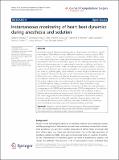Instantaneous monitoring of heart beat dynamics during anesthesia and sedation
Author(s)
Valenza, Gaetano; Akeju, Oluwaseun; Pavone, Kara J; Citi, Luca; Hartnack, Katharine E; Sampson, Aaron; Barbieri, Riccardo; Purdon, Patrick Lee; Brown, Emery N.; ... Show more Show less
Downloads40244-014-0013-2.pdf (2.512Mb)
OPEN_ACCESS_POLICY
Open Access Policy
Creative Commons Attribution-Noncommercial-Share Alike
Terms of use
Metadata
Show full item recordAbstract
Anesthesia-induced altered arousal depends on drugs having their effect in specific brain regions. These effects are also reflected in autonomic nervous system (ANS) outflow dynamics. To this extent, instantaneous monitoring of ANS outflow, based on neurophysiological and computational modeling, may provide a more accurate assessment of the action of anesthetic agents on the cardiovascular system. This will aid anesthesia care providers in maintaining homeostatic equilibrium and help to minimize drug administration while maintaining antinociceptive effects. In previous studies, we established a point process paradigm for analyzing heartbeat dynamics and have successfully applied these methods to a wide range of cardiovascular data and protocols. We recently devised a novel instantaneous nonlinear assessment of ANS outflow, also suitable and effective for real-time monitoring of the fast hemodynamic and autonomic effects during induction and emergence from anesthesia. Our goal is to demonstrate that our framework is suitable for instantaneous monitoring of the ANS response during administration of a broad range of anesthetic drugs. Specifically, we compare the hemodynamic and autonomic effects in study participants undergoing propofol (PROP) and dexmedetomidine (DMED) administration. Our methods provide an instantaneous characterization of autonomic state at different stages of sedation and anesthesia by tracking autonomic dynamics at very high time-resolution. Our results suggest that refined methods for analyzing linear and nonlinear heartbeat dynamics during administration of specific anesthetic drugs are able to overcome nonstationary limitations as well as reducing inter-subject variability, thus providing a potential real-time monitoring approach for patients receiving anesthesia.
Date issued
2014-11Department
Massachusetts Institute of Technology. Department of Brain and Cognitive SciencesJournal
Journal of Computational Surgery
Publisher
Springer
Citation
Valenza, Gaetano et al. “Instantaneous Monitoring of Heart Beat Dynamics during Anesthesia and Sedation.” Journal of Computational Surgery 3.1 (2014): n. pag.
Version: Final published version
ISSN
2194-3990